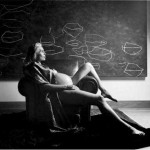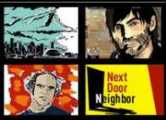Jason Bitner is the co-creator of Found, the on and offline show-and-tell project of lost and tossed items. He also edits Dirty Found, the X-rated version of the project.
Click here to go straight to the photos.
Click here to buy the book.
“The collection reads like an incredibly beautiful census, with expertly lit faces replacing biographical data.”
The highway from my home in Chicago to LaPorte, Indiana, hugs the southeastern edge of Lake Michigan. Heading away from Chicago’s landmark skyscrapers, you soon pass the rundown high-rises of the South Side, bypass the smokestacks and casinos of Hammond and Gary, Indiana, and exit near the scenic Michigan City, Indiana.

The roads become smaller and more affected by the quiet rolls of pastureland and the out-of-place vineyard. You’ll pass a small airport, some garage sales and cigarette stores, and a few horses. You’ll cross the train tracks, which supplied this former vacation destination with visitors from Chicago. And before long, Lake Michigan and her surrounding sandy dunes will be left in the rearview mirror, and a smallish Midwestern town will appear near the edge of South Pine Lake.
A few years back, I got wind of the LaPorte County Fair and its legendary demolition derby. Legendary like your ears will ring until Monday and you might get lucky and see a super-sized man booty-dancing on the roof of his broke-down station wagon. Not to mention this very fair has brought people together each year since 1836-before radio, before my grandparents were born, and even before the California Gold Rush. With this in mind, a friend and I drove out toward the fairgrounds early on a beautiful Saturday morning to guarantee some tickets for the evening’s show.
When heading to LaPorte, you use the monstrous overpass (built to ensure that 18 wheelers would have an efficient in-and-out of the city), and drive by the monumental courthouse designed by Chicago’s acclaimed city planner, Daniel Burnham, in 1894. If you stop by the local historical society situated behind the courthouse, you might learn about the Kingsbury Ordnance Plant, the local munitions factory, which produced a huge number of shells for World War II. You might come across early farming equipment and the re-creation of a settler’s parlor room, and you might learn that LaPorte, “the door,” was so named because its prairie land allowed an easy passage to the new frontier, the West.
Traveling into town on the sleepy thoroughfare, we decided to stop for a quick bite at B & J’s American Café, a classic old diner complete with an enormous counter, local gossip and friendly teens taking orders. Checking the menu, I noticed the cinnamon roll requires an extra fifteen minutes, and if a menu item asks for additional time, it must be a specialty. We ordered three and spent a few minutes watching people come and go.
As we sipped coffee at the counter and reviewed the LaPorte Herald-Argus, I noticed a couple of beautiful 5″ x 7″ black and white photos taped to the pie case. The paper was slightly yellowed and showing a few signs of wear, but these amazing portraits were from an entirely different era.
A couple years back, I helped create a show-and-tell project of discovered notes and photographs called Found Magazine. People from around the world sent us their discoveries, from lost and forgotten love letters to extensive and exhausting lists, from Polaroids to classroom notes-anything that gives a peek into another person’s life.
Sometimes a find comes as a loaded 20-word missive and other times we’ll receive an entire journal detailing an extended family’s history. Our intention is to see how people’s worlds are often very different in specifics-race and class and ability to spell-but also how we share similar emotions and difficulties and joys. Oftentimes all we know is our own world, and we can easily forget about lives that don’t directly impact our own.
After tens of thousands of submissions, I’ve grown accustomed to receiving these wonderful and unexpected finds in my mailbox, and every once in a while there’s a treasure in the alley behind my apartment. As the project brings dozens of to-do lists, missives from angry neighbors, and break-up notes to us each week, I’ve learned where to look for the prized keepers.
Nothing I’ve seen since the project began, however, could match the scale of what I was about to happen upon in the diner.
I asked the waitress about the photos and she pointed toward a door leading to an unused dining area. The near side of the room was reserved for rolling silverware into paper napkins, while the back of the room housed two large metal shelving units holding 22 cardboard boxes. These boxes were stuffed with stacks and stacks of photos, all with remarkably similar characteristics. Initially, I guessed we were looking at 2000-3,000 photos, though I’d later hand count nearly 18,000 of these beauties.
“Find a family member! Photos $.50 each-or-$5.00 for a packet,” stated a small sign to the right of the shelves. Before us stood a nearly complete archive documenting the townspeople of mid-century LaPorte for sale-cheap!-in a quiet room of a local eatery. We rifled through an entire town’s population, as if it were a card catalog, a huge visual archive of Midwestern faces that were being unloaded two-for-a-dollar.
Diner owner John Pappas grew up in the building; he and his wife Billie passed along the details.
Back in the 1950s and 60s, the building’s second floor was home to Muralcraft Studios. Frank and Gladys Pease made their living by crafting kid’s photos, anniversary shots, senior portraits, engagement announcement pictures, and portraits for any event that called for a formal sitting. Frank photographed, while Gladys took care of the administrative end of the business and helped clients look their best for this special occasion.
A typical client would climb a long set of stairs, enter a small waiting area and be greeted by Gladys. After taking their coats, she would lead the subjects to either the men’s or women’s dressing room, and sit them before a mirror. Makeup might be applied, hair combed, ties adjusted, teeth checked for spinach. When everything looked satisfactory, they would head down a short hallway to greet Frank.
The back half of the space housed the studio, darkroom, and a storage area for props and the especially large lighting equipment. Pease shot with a medium-format camera (a few of the negatives still exist) and once he established his technique, he never wavered from the look; sitters’ hair and clothing styles changed over time, though the art direction never budged. This was not ego-driven work-Pease simply offered himself as a skilled photographer for hire and put clients’ needs before his own. Clearly he viewed his photography as a trade or a craft instead of an art form.
The photos that follow were never intended as final prints; rather these are proofs that were shipped to clients so they could determine which shot was most becoming, would look best on the mantle, or would be the most flattering to send to loved ones across the country. As clients were offered black and white or hand-colored final images, handwritten notes detailing the color of eyes, hair, and clothing mark the backs of these proofs to ensure eyes weren’t mistakenly tinted blue rather than hazel.
After running Muralcraft for decades, Frank Pease passed away in the early 1970s. Prior to his death, Pease kindly donated his photo equipment to the local high school (and it’s likely that some of the younger subjects honed their darkroom skills on the very enlarger of their first portrait) and the proofs were all left in the studio. These photos sat in storage for over 20 years, until Billie and John opened their restaurant in the early nineties. For the past decade, these photos have been quietly sitting for sale in their back room, along with a few remainders of the lighting setup, while the Muralcraft studio has been renovated into a spacious apartment.
So we hunkered down on the floor, picked up a few stacks of photos and were instantly transfixed. Flipping through the pictures, we discovered an enormous visual survey of the Midwest a generation back. These faces staring back conjured family members, close friends, distant acquaintances-even Hollywood glamour shots. The collection reads like an incredibly beautiful census, with expertly lit faces replacing biographical data. By carrying on with his commercial photo business practice, Pease unwittingly created an enormous and compelling historical document. He became an accidental historian.
We ordered our second meal and kept digging. Halfway through the first box, I’d already committed to somehow taking in each of the 18,000 photos. It’s addicting, and overwhelming, and you don’t just come across something this incredible and soon forget about it. Three boxes into the process, I decided to spend a week straight in the back room of B & J’s, sipping coffee, reading the local paper, and selecting a couple hundred of my favorites to share.
I discovered it’s real easy to become image-fatigued when handling hundreds of photos each day; this kind of repetition leads to excitement for oddballs and more peculiar photos. I tried to steer clear of this kind of sensationalism when choosing photos for this book. The pictures that follow are organized and ordered, though the themes may not always be obvious.
Pease became a stenographer of LaPorte. He surely didn’t intend on a life as a cultural secretary, but his career and his work have gained an importance beyond that of each individual image. For a single anniversary photo holds a little historical value, but a collection this vast, spanning over a generation will certainly hold greater cultural value.
And that the collection should come from LaPorte-the door, the entryway-well, the metaphor is almost embarrassingly obvious. Come take a peek at the Midwest in the 1950s and 60s.
Reprinted with permission from LaPorte, Indiana (Princeton Architectural Press).

Kathy and Hugh Tonagel posing for their engagement photo. Photographer Frank Pease reminded the young couple that the portrait would visually represent their engagement, which may account for their intense eye-lock. He tried to impress up them the gravity of the situation-and take the moment seriously. The Tonagels are still married and have four children, great basketball players, we hear. Hugh works at the 4-H, while Kathy works at the local hospital and is a great cook.

This one’s such sweet and intimate portrait, and one of the few truly candid moments found in the Pease archive. I love the distant gaze coupled with the bad toupee. We’ve heard rumors that the man on the left headed off to join the circus-no kidding-but we still haven’t gotten to the bottom of this one.

Patty Sallwasser still lives in LaPorte and works as a mortgage officer When she saw her photo, she exclaimed, “That’s my purple polka-dot dress, that’s me! My mom cut my hair; she made the dress. I remember that I chose the fabric.”

Garry Lenard lives and works in LaPorte as a dental supply salesman. His signature buzzcut earned him the nickname “Burrhead,” which he still answers to around town. “I’ve always had short hair. Maybe in college [it was longer]. I think all of us went through a phase with the Beatles. That was the big thing. And now if you look at the Beatles, they never even really had long hair.” He is now married with three kids.

David VanSchoyck’s brother Dewayne tells us David died at age 9. “We used to have our photos taken every year,” Dewayne said.

Matching outfits sometimes aren’t a great idea, but these twins pull off the look in a warm and charming fashion. There’s something so sweet about older twins who still match. This is Lily (Ahlgrim) Baker and Rose (Ahlgrim) Scherer-twin sisters who lived on Weller Avenue; Lily had one son, Billy, and Rose had one daughter, Jeanette.

Robert Charles Ewald graduated LaPorte High in 1952, where he was a member of the band; he later formed the Bobby Charles Band, and now lives in Minnesota.

Pease captures this LaPortean’s cosmopolitan style, somewhere between a flight attendant and a Bond Girl. This is Dale (Horne) Lehner who graduated LaPorte High in 1971; Her father managed the local JC Penny, and is remembered as a “a very good student and a very happy, kind, friendly classmate.” She now lives in Grand Rapids, Michigan.

What’s this big guy’s story? No one knows. But each week I hear from more and more folks from LaPorte, Indiana who see themselves in the pages of this book, get in touch, and fill in the blanks of the past 50 years. And when that happens this story of LaPorte, Indiana-a story I so randomly stumbled upon a few years ago-becomes just a little be better told.





































